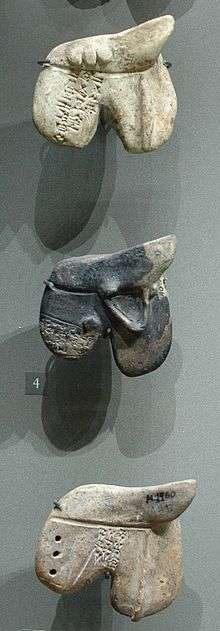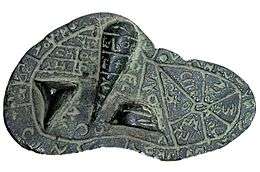Haruspex
In the religion of ancient Rome, a haruspex (plural haruspices; also called aruspex) was a person trained to practice a form of divination called haruspicy (haruspicina), the inspection of the entrails (exta—hence also extispicy (extispicium)) of sacrificed animals, especially the livers of sacrificed sheep and poultry. The reading of omens specifically from the liver is also known by the Greek term hepatoscopy (also hepatomancy).
The Roman concept is directly derived from Etruscan religion, as one of the three branches of the disciplina Etrusca. Such methods continued to be used well into the Middle Ages, especially among Christian apostates and pagans, with Thomas Becket apparently consulting both a haruspex and a chiromancer prior to a royal expedition against Brittany.[1]
The Latin terms haruspex, haruspicina are from an archaic word haru "entrails, intestines" (cognate with hernia "protruding viscera", and hira "empty gut"; PIE *ǵʰer-) and from the root spec- "to watch, observe". The Greek ἡπατοσκοπία hēpatoskōpia is from hēpar "liver" and skop- "to examine".
Ancient Near East

The spread of hepatoscopy is one of the clearest examples of cultural contact in the orientalizing period. It must have been a case of East-West understanding on a relatively high, technical level. The mobility of migrant charismatics is the natural prerequisite for this diffusion, the international role of sought-after specialists, who were, as far as their art was concerned, nevertheless bound to their father-teachers. We cannot expect to find many archaeologically identifiable traces of such people, other than some exceptional instances.
— Walter Burkert, 1992. The Orientalizing Revolution: Near Eastern Influence on Greek Culture in the Early Archaic Age (Thames and Hudson), p. 51.
The Babylonians were famous for hepatoscopy. This practice is mentioned in the Book of Ezekiel 21:26:
"For the king of Babylon standeth at the parting of the way, at the head of the two ways, to use divination; he shaketh the arrows to and fro, he inquireth of the teraphim, he looketh in the liver".[2][3]
The Nineveh library texts name more than a dozen liver-related terms. The liver was considered the source of the blood and hence the basis of life itself. From this belief, the Babylonians thought they could discover the will of the gods by examining the livers of carefully selected sheep. A priest known as a bārû was specially trained to interpret the "signs" of the liver, and Babylonian scholars assembled a monumental compendium of omens called the Bārûtu. The liver was divided into sections, with each section representing a particular deity.
One Babylonian clay model of a sheep's liver, dated between 1900 and 1600 BC, is conserved in the British Museum.[4] The model was used for divination, which was important to Mesopotamian medicine. This practice was conducted by priests and seers who looked for signs in the stars, or in the organs of sacrificed animals, to tell them things about a patient's illness. Wooden pegs were placed in the holes of the clay tablet to record features found in a sacrificed animal's liver. The seer then used these features to predict the course of a patient's illness.
Haruspicy was part of a larger study of organs for the sake of divination, called extispicy, paying particular attention to the positioning of the organs and their shape. There are many records of different peoples using the liver and spleen of various domestic and wild animals to forecast weather. There are hundreds of ancient architectural objects, labyrinths composed of cobblestones in the northern countries that are considered to be a model of the intestines of the sacrificial animal, i.e. the colon of ruminants.
The Assyro-Babylonian tradition was also adopted in Hittite religion. At least thirty-six liver-models have been excavated at Hattusa. Of these, the majority are inscribed in Akkadian, but a few examples also have inscriptions in the native Hittite language, indicating the adoption of haruspicy as part of the native, vernacular cult.[5]
Haruspicy in Ancient Greece
Divination called haruspicy was also practiced in ancient Greece. Several Greek vases show images of liver divination.
Haruspicy in Ancient Italy
In Italy, divination was practised by the Etruscans, the Romans and the Umbrians. The Etruscans were well known for the practice of divining by the entrails of sheep. A bronze sculpture of a liver known as the "Liver of Piacenza", dating to around 100 BC, was discovered in 1877 near the town of Piacenza in northern Italy. It is marked with the name of regions assigned to various deities of Etruscan religion.
The art of haruspicy was taught in the Libri Tagetici, a collection of texts attributed to Tages, a childlike being who figures in Etruscan mythology, and who was discovered in an open field by Tarchon; the Libri Tagetici were translated into Latin and employed in reading omens.
The continuity of the Etruscan tradition among the Romans is indicated by several ancient literary sources, perhaps most famously in the incident related by Suetonius[6] in which a haruspex named Spurinna warned Julius Caesar to beware the Ides of March.
The emperor Claudius was a student of the Etruscan language and antiquities, and opened a college to preserve and improve their art, which lasted until the reign of Theodosius I, the Christian emperor who dismantled the last active vestiges of the traditional state cult. Further evidence has been found of haruspices in Bath, England where the base of a statue was dedicated by a haruspex named Memor.
See also
References
- Thorndike, Lynn (1923). A history of magic and experimental science. 2. New York, Macmillan. p. 167.
- "Ezekiel 21". Hebrew Bible in English. Mechon-Mamre.
- See also: Darshan, Guy, “The Meaning of bārēʾ (Ez 21,24) and the Prophecy Concerning Nebuchadnezzar at the Crossroads (Ez 21,23-29),” ZAW 128 (2016), 83-95.
- The Liver tablet 92668.
- four specimens are known to Güterbock (1987): CTH 547 II, KBo 9 67, KBo 25, KUB 4 72 (VAT 8320 in Vorderasiatisches Museum Berlin), for which see also George Sarton, Ancient Science Through the Golden Age of Greece (1952, 1970), p. 93, citing Alfred Boissier, Mantique babylonienne et mantique hittite (1935).
- Suetonius, Divus Julius 81.
Bibliography
- Walter Burkert, 1992. The Orientalizing Revolution: Near Eastern Influence on Greek Culture in the Early Archaic Age (Thames and Hudson), pp 46–51.
- Derek Collins, "Mapping the Entrails: The Practice of Greek Hepatoscopy" American Journal of Philology 129 [2008]: 319-345
- Marie-Laurence Haack, Les haruspices dans le monde romain (Bordeaux : Ausonius, 2003).
- Hans Gustav Güterbock, 'Hittite liver models' in: Language, Literature and History (FS Reiner) (1987), 147–153, reprinted in Hoffner (ed.) Selected Writings, Assyriological Studies no. 26 (1997).
External links
- Chisholm, Hugh, ed. (1911). . Encyclopædia Britannica. 13 (11th ed.). Cambridge University Press. pp. 37–38. This source suggests that Greek and Roman haruspices used the entrails of human corpses; the victim should be "without spot or blemish".
- Haruspices, article in Smith's Dictionary of Greek and Roman Antiquities
- Figurine of Haruspex, 4th Cent. B.C. Vatican Museums Online, Gregorian Etruscan Museum, Room III
- l. Starr (1992). "Chapters 1 and 2 of the bārûtu". State Archives of Assyria Bulletin. 6: 45–53.


